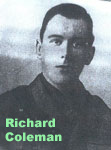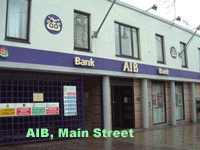Richard Coleman
|
VocationHe hoped to become a priest, but the clergy in Swords did not sponsor him for a place in the seminary, so he became a Christian Brother instead. He left the Christian Brothers after four years, and worked at a number of jobs before being appointed agent in Swords for the Prudential Insurance Company. This job suited him very well because it gave him time for his other activities. Irish VolunteersIn 1914 he was enrolled along with others in the Irish Volunteers with Thomas Mc Donagh. They met in the school grounds for training in drill. In 1914, the volunteers split between those who advocated helping the British army in the World War, and those who were opposed to this course of action. Coleman was elected captain of the Fifth Battalion also known as the Fingal Brigade. Among the other members were Frank Lawless (after whom Fingallians GAA pitch is named), Thomas, Joe and Christopher Taylor, Peter Wilson, and John Grenigan (killed at the battle of Ashbourne). Easter 1916On Easter Monday, 1916, the men of the Fingal Brigade met at Knocksedan Bridge, and they camped at Finglas at Premier Dairies on that night. On Tuesday, Thomas Ashe was asked by James Connolly to send forty men to Dublin city. Ashe decided to send twenty and the remainder fought the Battle of Ashbourne under the command of Frank Lawless. Coleman went first to the GPO, and then to the Mendicity Institute where the garrison was under the command of Sean Heuston. It was here that Peter Wilson from Swords was killed. Dartmoor Prison
UskIn May 1918 he was arrested again, and imprisoned in Usk. He died of pneumonia on the ninth of December in 1918. School PlaqueOn the 50th anniversary of his death, there was a Mass in Swords which was attended by Eamon de Valera, President. After the Mass, a plaque was unveiled in our school. |








